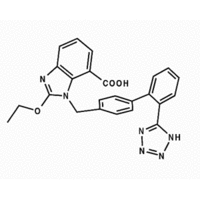Objective: To demonstrate the optimal doses of angiotensin receptor blockers for maximal inhibition of the Renin-Angiotensin System in order to achieve maximal reduction of proteinuria and blood pressure. The aim of this investigation was to evaluate the safety and efficacy of high dose candesartan cilexetil (160mg) in humans.
Design and Methods: Twelve subjects (mean = 60.4 yrs., 9 males) with hypertension and both diabetic and non-diabetic renal diseases were studied. The baseline glomerular filtration rate ranged from 30-83 ml/min. All subjects excreted greater than 500mg/day of protein. All patients were angiotensin receptor blocker naive and angiotensin converting enzyme inhibitors were discontinued at the start of the study. Then the subjects were titrated up to 160mg of candesartan cilexetil during month one, and maintained on this dose for the second month. Measurements, taken at various times included: blood pressure, 24-hour urinary protein, creatinine clearance, serum creatinine, serum potassium and urinary electrolytes. In order to determine safety and efficacy, all measurements were analyzed by students' paired t test comparing the data from the screening period with data at the end of the study. Efficacy was determined by changes in systolic and diastolic blood pressure and 24-hour urinary protein excretion. The safety of candesartan cilexetil 160mg was determined by monitoring for adverse effects, and by monitoring levels of serum creatinine and potassium, and urinary creatinine clearance. For this research, an Investigational New Drug (IND) Number was obtained from the Food and Drug Administration. Investigational review board approval was obtained.
Results: Twenty-four hour urinary protein excretion was reduced by 30% (4.23 to 2.98 g/day, p=0.01 5). There were significant reductions in both systolic (138 +/-17 to 127 +/-17 mmHg, p=0.015) and diastolic (84 +/- 13 to 77 +/-13, p=0.014) blood pressure. During this investigation no significant adverse effects were reported. There were no changes in serum creatinine or serum potassium (2mg/dl, 4.8 to 4.9 mEq/l, respectively). Creatinine clearance rates were unchanged. Also, there were no changes in urinary sodium (150.7+/- 78 to 158+/-59, p=0.446) and potassium (64.82+7-78 to 65.8+7-21, p=0.415).
Conclusions: Candesartan cilexetil (160mg) is effective in lowering systolic and diastolic blood pressure and 24-hour urinary protein excretion. Furthermore, high closes of candesartan cilexetil were observed to be safe without significant adverse effects. All measurements of both urinary and serum creatinine and potassium as well as creatinine clearance remained unchanged. Future investigations are warranted to determine whether higher doses of candesartan cilexetil can induce maximal reduction of proteinuria and tissue protection.
Judy L. Brasier, DO; Adam J. Weinberg; Renee Haneiwich, MA; Marc S, Weinberg, MD
Division of Nephrology, Roger Williams Medical Center and Miriam Hospital, Providence, Rhode Island, USA
Copyright Rhode Island Medical Society Jan 2004
Provided by ProQuest Information and Learning Company. All rights Reserved



